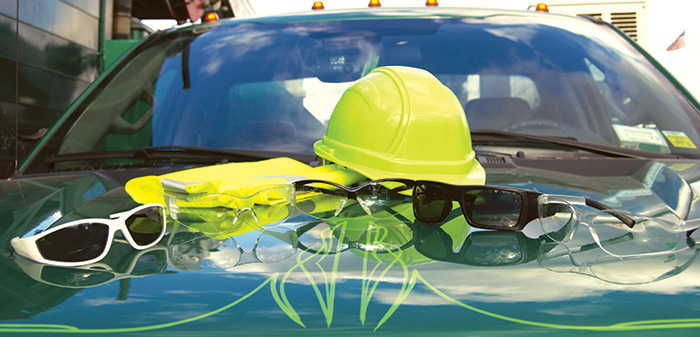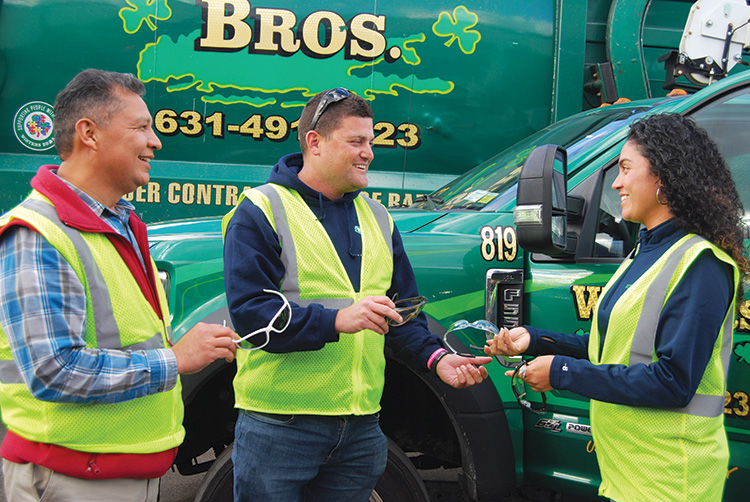According to the OSHA, each day about 2,000 workers sustain a job-related eye injury that requires medical treatment. Many of these injuries could be prevented with the proper selection and use of eye and face protection.
By Will Flower
People have five senses—sight, taste, smell, touch, and hearing. By far, sight provides the greatest amount of sensory perceptions with up to 80 percent of all impressions provided through the eyes, making them an important organ. Protecting the eyes is critical. Even a small object from a broken tool to an errant ejection from the hopper on a truck can result in an eye injury ranging from irritation to complete blindness.
Most eye injuries result from small particles or objects striking or scraping the eye. These small particles are often windblown, but could also be ejected by tools or machines. Large objects may also strike the eye or face, resulting in blunt-force trauma to the eyeball or eye socket.
Workers on packer trucks are especially susceptible to flying objects when waste is being compacted into a rear-end loading collection vehicle. Workers should never stand behind the hopper, rather off to the side in the event an item becomes airborne. Additionally, cans, jars, and jugs containing a variety of liquid chemicals can puncture or rupture, resulting in a spray of dangerous liquids.

Photos courtesy of Will Flower.
Safety professionals should conduct a hazard assessment to determine the appropriate type of protective eye wear appropriate for a given task. Selecting the necessary protective eyewear may range from safety glasses to goggles or even full-face shields.
Workers may give any number of excuses for not wearing eye protection. The most common are that the safety glasses fog, are uncomfortable, are hot, do not fit right, or just do not look cool. In other cases, workers may believe that eye protection is unnecessary. However, injuries can happen in a split-second, resulting in a trip to the emergency room.
Selecting Eye Protection
Not all faces are the same and employees should select a pair of safety glasses that are comfortable and provide the necessary protection. Poor fitting eye protection can be a distraction rather than protection. Eye
protection should also allow for sufficient peripheral vision. Companies should provide a variety of eye protection in various colors and styles. Glasses should be secure, but not too tight. Glasses that are too close to the face can result in
excessive fogging due to limited circulation of air around the lens. Eye protection with tinting may also be helpful when employees are working outdoors.
Keep Glasses Clean and Fog-Free
If an employee cannot see due to smudges or fogging of their eye protection, the quickest reaction is to remove the safety glasses, thereby placing the employee at risk. Employers should provide cleaning wipes and encourage employees to clean their glasses throughout the day. Fogging is a big concern when wearing glasses because it can limit or cloud your view. To prevent glasses from fogging, workers should use anti-fog wipes or sprays.

Use, Storage and Care
Workers should always follow the manufacturer’s guidance for cleaning, storage and care of eye protection equipment. Special care should be taken to prevent scratching and damage. Workers should also inspect eye protection prior to use. Any damaged equipment should not be used. Lenses that are pitted or scratched should be replaced.
Education
Employees should be reminded that eye protection is important. OSHA requires employers to ensure the safety of all employees in the work environment. Eye and face protection must be provided whenever necessary to protect against liquid, particles, or other threats to the eyes or face.
Prevent Blindness America, the nation’s oldest eye health and safety organization estimates that more than 90 percent of workplace eye injuries are preventable with proper eye protection. Most importantly, eye protection must be worn to be
effective. A pair of safety glasses that are on top of workers’ heads or in their pockets instead of over their eyes will be of little value when needed. Safety glasses, goggles and face shields can protect employee’s most critical sense—their sight. | WA
Will Flower is the Senior Vice President of Corporate and Public Affairs at Winters Bros. Waste Systems.
Share your safety tip. Submit your suggestions to Will Flower at [email protected].
